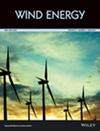Mechanical–electrical‐grid model for the doubly fed induction generator wind turbine system considering oscillation frequency coupling characteristics
IF 3.3
3区 工程技术
Q3 ENERGY & FUELS
引用次数: 0
Abstract
Abstract With the evolution of renewable energies, many doubly fed induction generators (DFIGs) are being connected to the power grid, whose operation and grid‐connection stability have a major impact on the power grid. Currently, most studies focus on either modeling the mechanical–electrical section or the electrical‐grid section, and discussions have been limited to shaft oscillation or frequency coupling problems. In this study, a mechanical–electrical‐grid model of a DFIG was established to examine the impacts of wind speed and system control parameters on electrical damping and grid‐connection stability. The accuracy of the proposed model and validity of the analyses were verified using simulations. The following were observed: (1) In the case of changing wind speeds, the wind speed and the applied control model determine the shaft oscillation of DFIG, whereas the grid‐connected impedance on the rotor side is dependent on the wind speed. (2) At a constant wind speed, changes in control parameters under different control modes affect the dynamic characteristics of the drive train differently, whereas the grid‐connected impedance on the rotor side is primarily determined by the proportional gain of the inner/outer loop of the control system. The conclusions drawn from this study can further improve the safe and stable operation of DFIG wind power generation systems as well as their connection to the power grid.考虑振荡频率耦合特性的双馈感应发电机风力发电系统机电网格模型
随着可再生能源的发展,越来越多的双馈感应发电机(DFIGs)接入电网,其运行和并网稳定性对电网有着重要的影响。目前,大多数研究都集中在机电部分或电网部分的建模上,并且讨论仅限于轴振荡或频率耦合问题。在本研究中,建立了DFIG的机电电网模型,以研究风速和系统控制参数对电阻尼和并网稳定性的影响。仿真结果验证了模型的准确性和分析的有效性。结果表明:(1)在风速变化的情况下,风速和所应用的控制模型决定了DFIG的轴振,而转子侧的并网阻抗则取决于风速。(2)在恒定风速下,不同控制方式下控制参数的变化对传动系动态特性的影响不同,转子侧的并网阻抗主要由控制系统内外环的比例增益决定。本研究的结论可以进一步提高DFIG风力发电系统的安全稳定运行和并网性能。
本文章由计算机程序翻译,如有差异,请以英文原文为准。
求助全文
约1分钟内获得全文
求助全文
来源期刊

Wind Energy
工程技术-工程:机械
CiteScore
9.60
自引率
7.30%
发文量
0
审稿时长
6 months
期刊介绍:
Wind Energy offers a major forum for the reporting of advances in this rapidly developing technology with the goal of realising the world-wide potential to harness clean energy from land-based and offshore wind. The journal aims to reach all those with an interest in this field from academic research, industrial development through to applications, including individual wind turbines and components, wind farms and integration of wind power plants. Contributions across the spectrum of scientific and engineering disciplines concerned with the advancement of wind power capture, conversion, integration and utilisation technologies are essential features of the journal.
 求助内容:
求助内容: 应助结果提醒方式:
应助结果提醒方式:


